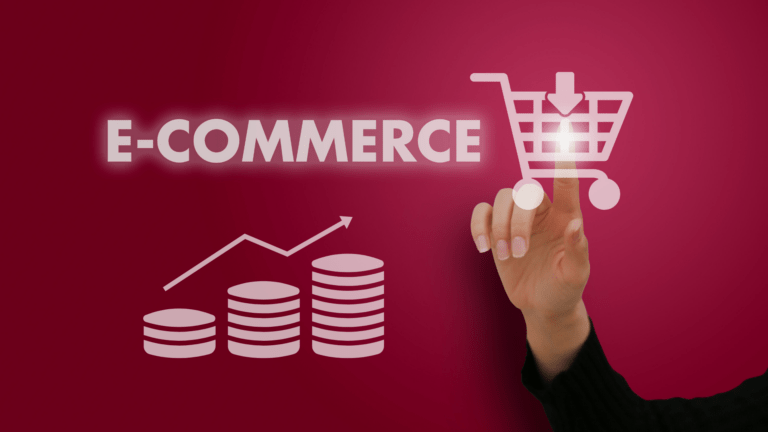Due to the pandemic last year, the retail industry was thrown into chaos. However, unfavorable world circumstances accelerated the expansion of digital sales. According to statistics –46% of Americans tried a new brand or placed orders with new shops last year.
Smaller e-commerce retailers had a 96.5 percent increase in web traffic from October 2019 to October 2020. The amount of sales from inexperienced or infrequent e-commerce users is predicted to climb by 160 percent in the future, according to a May 2020 Accenture study. In 2020, U.S. consumers spent more than $190 billion via mobile.
The present article throws light on the e-commerce sector, how to create a successful online store and market presence, the different e-commerce platforms for e-commerce websites according to a business’s suitability, so on and so forth.
What is an e-commerce store?
Consumers can buy or sell products or services via an online interface or the internet at an internet store, also known as an internet store or an electronic store. These transactions are carried out using an online money transfer. It is a well-known business concept that lets individuals and businesses transact goods, services, and information over the internet.

The e-commerce model operates in four aspects – Business to Business (B2B), Business to Consumer (B2C), Consumer to Consumer (C2C), Consumer to Business (C2B).
The increasing importance of eCommerce can be explained by the fact that it has assisted many entrepreneurs, small businesses, and startups gain a larger market presence and penetration by providing affordable and efficient distribution channels for customers to enjoy their goods, products, and services.
Many online retailers now use their websites to conduct online or e-commerce transactions. Some online merchants choose to start their businesses on large online marketplaces such as Amazon, eBay, and others. These platforms enable trades between many sellers and buyers who have come together to accomplish a business transaction.
Here is how you can create a highly profitable e-commerce business
Step 1: Do some research in the e-commerce space and find your specialty
Conducting appropriate research is step one in establishing an e-commerce company. You’ll want to explore the e-commerce arena you’re interested in and make some judgments about your unique business, just like you would if opening a restaurant and looking into different locations, cuisine selections, and themes.
Although the expansion of the e-commerce market is beneficial to individuals knowing how to start an e-commerce company, it also means that there is more competition. You should conduct a competitive analysis and identify a market where you believe you can create your brand and sell items and services.
Step 2: Choose a name for your company and a legal structure
After you’ve decided on your e-commerce business strategy, the next step is to choose a name. You’ll want a company name that is unique and identifies what your company is or does, just like any other organization. When choosing a name for your e-commerce venture, consider business name ideas that encapsulate your brand essence. It’s about more than just a name—it makes your business recognizable. To make sure you’re not choosing a name that’s been already claimed by another company, visit the websites of your local secretary of state and the U.S. Patent and Trademark Office. Additionally, understanding overheads like trademarking expenses is crucial for setting your business apart and protecting it against copying or fraud. Securing a trademark can influence not only your brand’s uniqueness but also infuse trust among your consumers.
Next, decide on the legal framework of your company. The legal and financial ramifications of the entity type you choose for your e-commerce company are important. In most cases, you’ll form a sole proprietorship, general partnership, LLP, or a corporation. Each organization type has pros and cons, so you may want to seek legal advice from an attorney or other legal professional to decide which is the best option for your company.
Step 3: Obtain an EIN
For your e-commerce business, you’ll need to apply for an employer identification number. However, not all businesses are required to obtain an EIN, this nine-digit number can help you keep your personal and business finances separate. Not only that, but you need an EIN to get a business bank account. This will make it easier for you to use services like www.getmoss.com/en-gb, which allow you to control your finances smartly. Additionally, you can get an EIN from the IRS for free by applying online, by mail, fax, or by phone. As you’re learning how to start an e-commerce company, you’ll probably want to apply for this business tax I.D. online, and you’ll get your number almost immediately.
Step 4: Obtain the necessary permits and licenses for your business
After you’ve got your EIN, you’ll need to secure any necessary business licenses or permissions to operate legally in your city and state. You don’t need to incorporate your e-commerce organization with the state if you’ve formed it as a sole proprietorship or general partnership, as discussed above — unless you’re filing a DBA to legally operate under a particular business name. However, you must register your business with your state and obtain a general operating license for the other business entity categories. You may also need to acquire a municipal operating license, depending on your firm’s location.
Most e-commerce organizations do not require as many business licenses and permissions as brick-and-mortar establishments because they are operated from home. You’ll need to figure out the precise criteria in your area, which you can usually find out by visiting your state government’s website. Most places, for instance, require home-based business owners to get a home occupation permit to legally operate. This permit just certifies that conducting your business out of your home does not increase traffic, noise, or other undesirable situations in your neighborhood.
Step 5: Create your website using an e-commerce platform
You’ve completed the documentation required to incorporate and lawfully start your e-commerce firm at this point. This way, most of our previous processes have mimicked the process of launching a physical store. Instead of looking for an ideal location and planning to open a physical store, you’ll instead focus on creating your website and online store.
The most important decision you’ll make is which e-commerce platform to use. Your e-commerce platform, whether it’s all-in-one software like Shopify or an open-source platform like Magento, will be the base on which you construct and develop your business.
Most e-commerce platforms let you customize your design, add your domain (or buy one), manage inventory, take and ship orders, accept payments, and more.
Step 6: Product development or sourcing (and listing)
You can produce your own products, buy them from wholesalers, or — if you’re offering your services, such as a consultant — just describe and list them on your website.
If you’re selling things, this stage will be more complex because you’ll need to consider how much inventory you’ll need to start, as well as what your initial expenses will be. You’ll also want to take the time to list your inventory, considering the UX, SEO, and how the process will operate from the time a consumer orders an item to the time they receive it.
Step 7: Promote your e-commerce store.
Now that you’ve prepared your products or services and put them in your store you’re ready to begin servicing consumers, as your website is up and running.

You can use a variety of marketing tactics, such as Google AdWords, social media ads, word-of-mouth marketing, etc. At the most basic level, you’ll want to optimize your business website for SEO and use any online marketing tools your e-commerce platform provides.
Different eCommerce platforms for your e-commerce store
Shopify:
Shopify is a popular eCommerce platform that enables online merchants and traders to create an online shop and sell goods and services. Traders can also sell their products personally using Shopify POS.
This platform has been around for a decade and is now considered one of the best eCommerce systems accessible. This platform is ideal for merchants that sell their wares on social media, online, or even from the trunk of their car. Entrepreneurs use Shopify in over 175 countries to sell their goods.
WooCommerce:
WooCommerce is a WordPress-based open-source, highly configurable eCommerce platform. WooThemes, a platform that provides eCommerce solutions, was founded in 2008 it later became ‘WooCommerce’. In 2017, the company focused entirely on eCommerce solutions after a few years.
Today, this organization is in charge of enabling startups, small and medium-sized businesses, and entrepreneurs to create their own stores and sell their items online. It’s a WordPress plugin that helps you run an online store by making your WordPress site eCommerce functional.
BigCommerce:
It is one of the most popular eCommerce systems, allowing online merchants and traders to set up an online store. The platform enables you to create an online store, expand its product offerings, and begin making cash from the site.
It includes various data tools, built-in features, and solutions that make business transactions more straightforward and more efficient. This platform is regarded as one of the best, particularly for rapidly expanding firms.
Magento:
Magento is another eCommerce platform that enables clients to enjoy a seamless combination of physical and digital buying experiences. The platform enabled many brands and retailers to expand and innovate at a rapid pace by combining an eCommerce platform with flexible cloud solutions.
Magento has created an open-cart system that allows users to have complete control over their online store’s appearance, operation, and content. Search engine optimization, strong marketing, and catalog management features are all available through the platform.
Volusion:
Volusion is an eCommerce website builder that offers high-end features like marketing, web design, and more to online retailers. The platform offers monthly plans with services and tools, varying prices depending on specific requirements.
It was founded in 1999 and is now responsible for over 40,000 internet stores. It makes it easier for online merchants to run their businesses and provides distinctive features that help them stand out from the crowd.
3dCart:
3dCart is a powerful and comprehensive eCommerce platform that enables online merchants and traders to grow, succeed, and prosper. The platform comes with several features pre-installed.
Merchants can open, maintain, and operate a fantastic website with utmost efficiency and convenience using these capabilities. Today, this platform serves businesses of different sizes and scopes.
Prestashop:
Prestashop is a free and open-source e-commerce platform written in PHP. The platform is compatible with the MySQL database management system and is available under the Open Software License. It provides service to over 300,000 stores all around the world. It has a lot of capabilities that can be utilized to run self-hosted stores.
Conclusion
The increasing importance of eCommerce can be explained by the fact that it has aided many entrepreneurs, small businesses, and startups in gaining a larger market presence and penetration by providing affordable and efficient distribution channels for customers to enjoy their goods, products, and services.
And for a successful eCommerce business and seamless customer experience, it is important to have an active AI-powered search bar for which one can avail the top-class services of Expertrec.
Expertrec also makes searching your eCommerce store easy with faster search results, offers real-time indexing and is highly versatile, and works on all platforms.
Frequently Asked Questions
Q1. How do I start an e-commerce store?
A1. Here are a few steps that will give you an idea of the bigger picture as to how to set up an e-commerce store –
- Choose the ideal business plan and model
- Brand your brand
- Create an account for your online store
- Set up a bank account
- Create a website for your e-commerce business
- configure payment gateways for your online store
- Set up logistics
- Build promotion techniques to attract customers
Q2. How can I make my business a highly profitable e-commerce business online?
A2. Here are a few tips that can make an e-commerce business profitable:
- Don’t rush the launch of an e-commerce website
- Put the focus on the user and the search bar as well
- First, test whatever you are planning to launch
- Work closely with social media
- Build mobile O.S. friendly e-commerce sites
- Enhance SEO rankings
- Collect customer information- choice and preferences
- Continue evolving
[saswp_tiny_multiple_faq headline-0=”h2″ question-0=”How do I start an e-commerce store?” answer-0=”Here are a few steps that will give you an idea of the bigger picture as to how to set up an e-commerce store – Choose the ideal business plan and model Brand your brand Create an account for your online store Set up a bank account Create a website for your e-commerce business configure payment gateways for your online store Set up logistics Build promotion techniques to attract customers ” image-0=”” headline-1=”h2″ question-1=”How can I make my business a highly profitable e-commerce business online?” answer-1=”Here are a few tips that can make an e-commerce business profitable: Don’t rush the launch of an e-commerce website Put the focus on the user and the search bar as well First, test whatever you are planning to launch Work closely with social media Build mobile O.S. friendly e-commerce sites Enhance SEO rankings Collect customer information- choice and preferences Continue evolving ” image-1=”” count=”2″ html=”false”]




